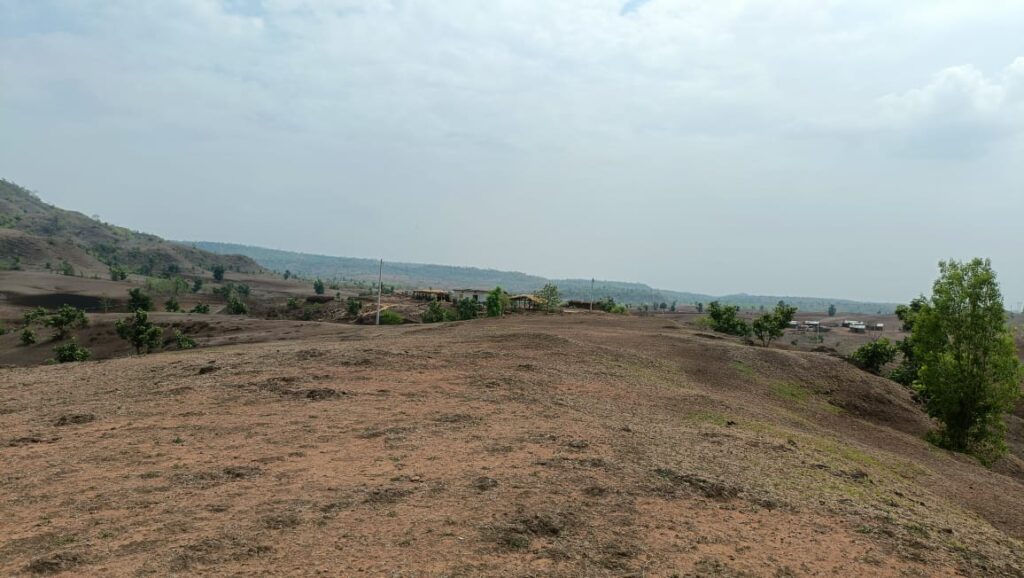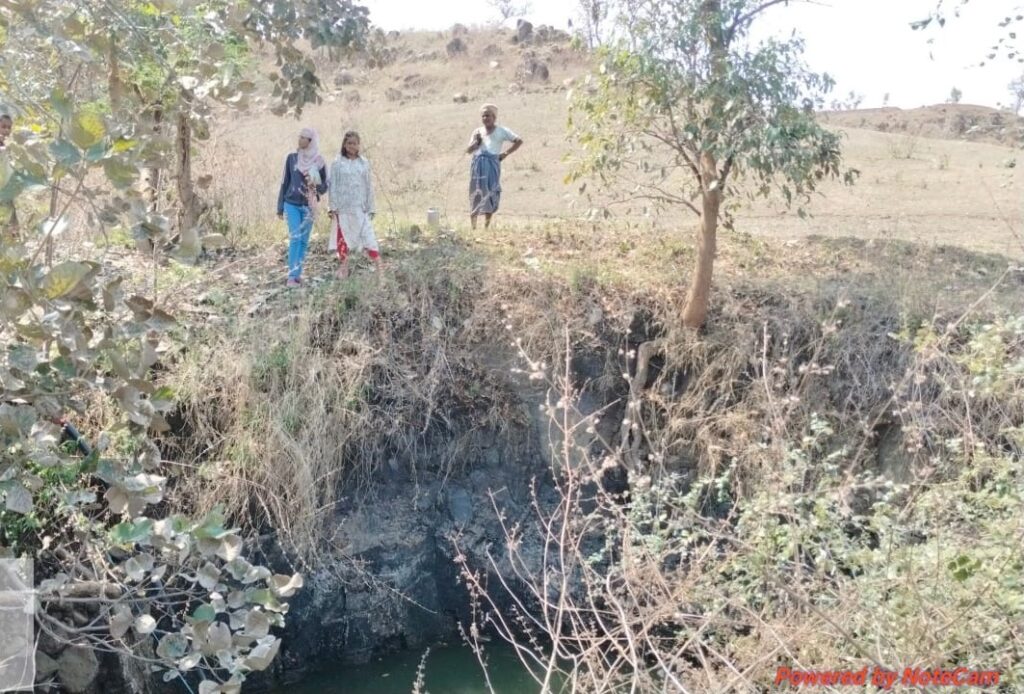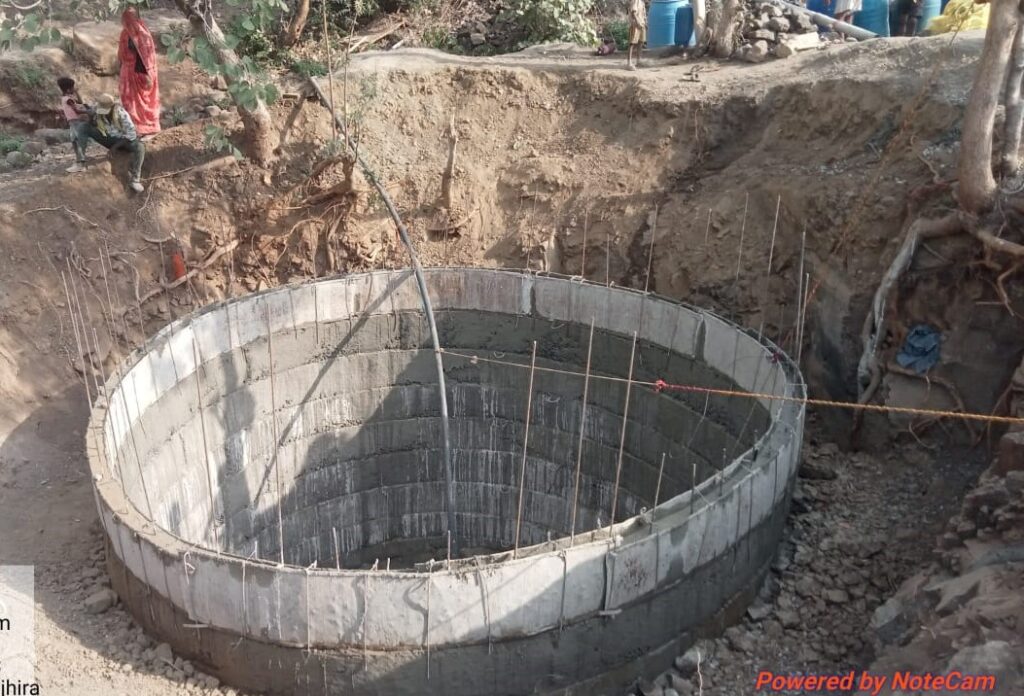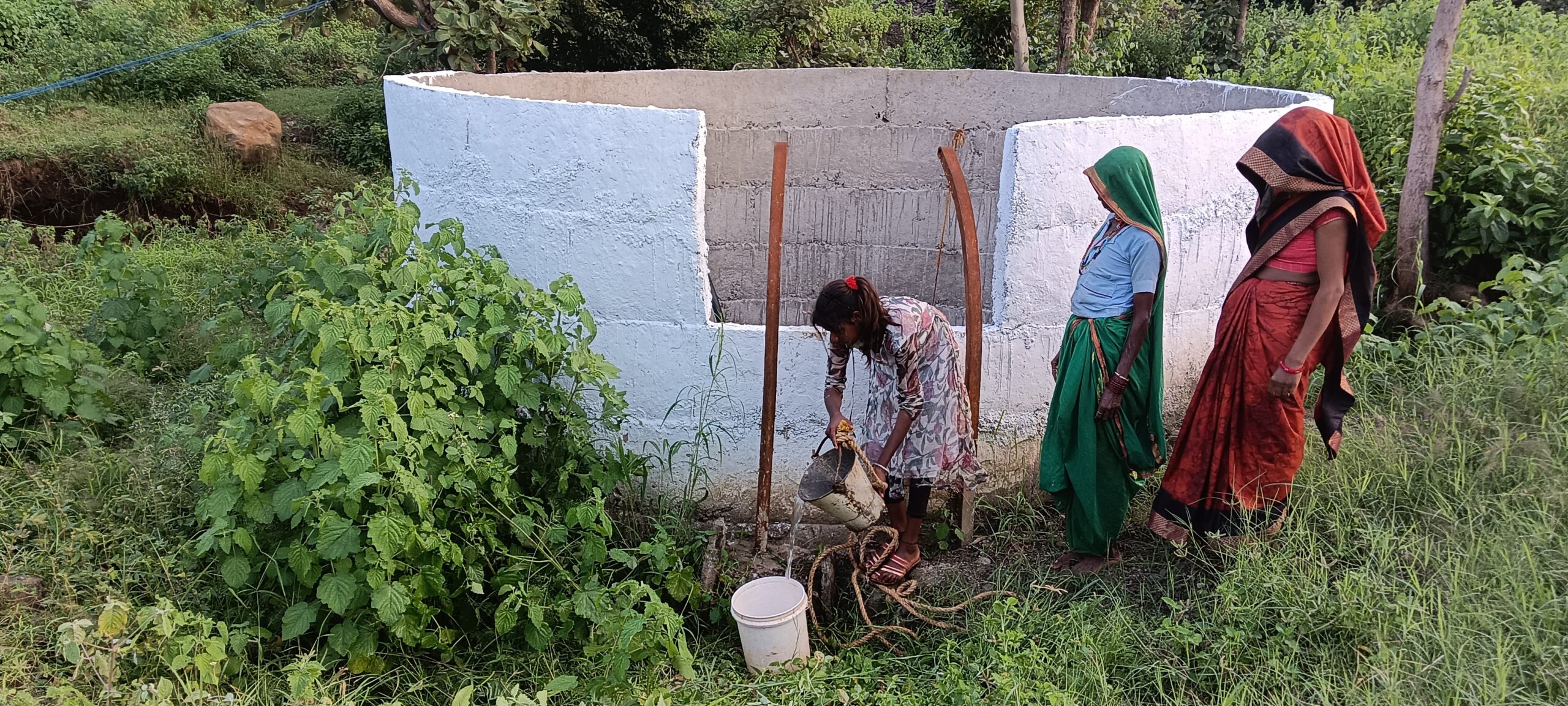Guljhira village is situated amidst the red laterite rocky hills of Bhagwanpura, a sub-division of Khargone district in Madhya Pradesh. The village comprises five “phalias” or neighbourhoods, one of which is Bedi Phalia, established a few years ago close to a hilltop some distance away, by 25 Adivasi families of the Bhil and Bilala communities. The farmers here depend on the seasonal kharif crops, corn and soyabean, but lack the irrigation facilities needed to be able to sow rabi crops. After Diwali, most inhabitants migrate in search of livelihood to work as labourers at construction sites in the towns of Maharashtra and Gujarat, or as agricultural labourers in Gujarat’s Porbandar district.

up the steep slope
From the outset, the inhabitants of Bedi Phalia have faced difficulties in accessing water for their daily needs, particularly in summer when the groundwater is at its most depleted . Located as they are, high up a hillside, they have no nearby water source. The women have to walk down to fill up water from a farmer’s personal borewell, but its water level is low and the owner switches on the motor for lifting up water for just half an hour. Besides, it often happens that there’s no electricity, which means people can’t get any water. Their last resort is the well belonging to farmer Dhema Kanase, which comes with its own set of problems. It is strenuous work, having to haul up filled buckets from the 35-foot deep well. Enough water needs to be drawn not only for a family’s drinking and other household needs, but also for their cattle. The residents of Bedi Phalia had taken their water woes to the village Sarpanch many times, but to no avail.

Bedi Phalia situated on the hill
Over the past year, Samaj Pragati Sahayog (SPS) has been working in Guljhira to promote watershed management,[1] set up Self-Help Groups, encourage NPM farming[2] and make safe drinking water available. When SPS workers held a meeting in the village in 2024, the people of Bedi Phalia spoke about their water crisis – adding that the interior of the well they were using did not have a strong lining, and its water was polluted by the garbage from the field around flowing into it because its mouth was at field level. They were forced to drink this polluted water, as they had no other water source nearby. The mud flowing in from the surrounding field also tended to block the inlet, reducing the base flow to a trickle in the summer months when the ground water started to get used up. And to make matters worse, the well had no protective boundary wall, and so the danger of people or animals falling in was always present. An SPS team found that the well water was contaminated with bacteria due to garbage going into the well. The Bedi Phalia residents wanted the well’s interior to be reinforced with cement-concrete right till the top – and lacking the means to do so themselves, they were seeking the organisation’s assistance.


discussing about well-repair with the village community
The SPS workers promised to provide the construction material, such as cement, stones, sand, and metal rods. They asked for “shramdaan” – for people to contribute their labour – and everyone agreed. The well’s owner was also in favour of the plan. Work began soon afterwards, with 15 persons from the neighbourhood taking part. A week later, however, they decided not to work for free and demanded wages for their labour. Workers from the organisation called for a meeting, at which they explained the significance of contributing labour. When SPS works with communities on any project, it ensures everyone’s participation. People may contribute in any form, whether cash, materials, or labour. The underlying notion is that when any developmental plan for a village is conceived along with the villagers, there needs to be a sense of shared ownership. This emotional bond inspires people to do their utmost towards the best possible outcome. Also, they have a collective role in decision-making when it comes to fixing and optimising expenses. The community members were asked to reflect on how the well was not being repaired for any individual’s use, but for the benefit of the entire neighbourhood. After long discussions spread over two days, and attempts at persuasion by the SPS workers, the people once again consented, unanimously, to donating their labour.

Condition of the well before the repair job

Well repairing work begins
The work, which took 17 days, was completed in June. Financial aid from the organisation came to Rs 1, 21, 463. After years, the residents of Bedi Phalia finally had access to clean drinking water. SPS plans to raise funds for laying a pipeline to bring a water tap to the neighbourhood, so that everyone there has water available for all 24 hours, right by their homes. There is also a plan to construct a water trough for cattle. Besides solving the water problem faced by the people of Bedi Phalia, this endeavour also serves as an excellent example of voluntary contribution of labour and mutual cooperation at the community level.

Well after the concrete lining

Women collecting water from the newly constructed well
This was done as part of SPS's watershed development programme, under which several projects have been completed in the organisation’s Bhagwanpura work location over the last ten months, including: four stop dams, maintenance work on a check dam, a field reservoir, two Gabion structures,[3] 26 boulder checks, repairs on one well, and building embankments on 327 hectares of land. Together, these works generated 36,651 human days of employment, and involved a total expenditure of Rs 1,87,78,000, of which Rs 6,48,000 was in the form of community-contributed labour.
[1] Watershed development involves building a range of structures for water conservation
[2]This is farming without chemical pesticides
[3] A Gabion structure is a wire box filled with rocks, used in watershed development to conserve stream flows as part of water conservation.
-
Writing: Pradeep Lekhwar
Source: Kirti Kelde, Mangalam Barnwal
Photography: Vipin Pal, Chhagan Dudwe, Sanju Kanase, Rabindra Kumar Barik
Translation (Hindi to English): Smriti Nevatia
Guidance: Pinky Brahma Choudhary
Page Layout: Roshani Chouhan

